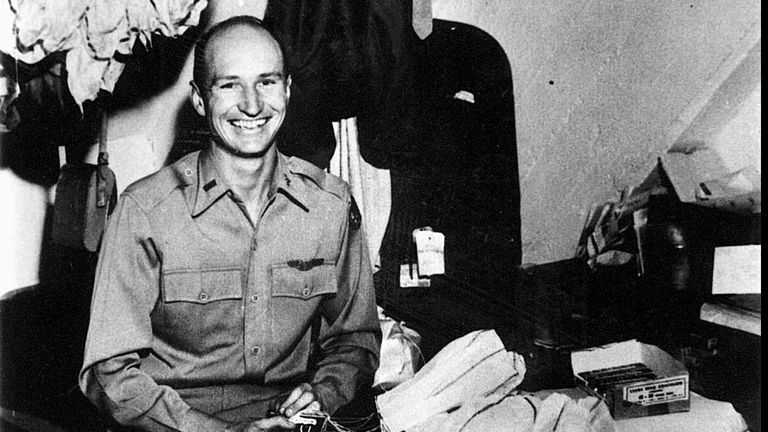Gail Halvorsen, known as the Berlin airlift’s Candy Bomber, has died at the age of 101.
Mr Halvorsen died on Wednesday in his home state of Utah following a short illness, according to James Stewart, the director of the Gail S Halvorsen Aviation Education Foundation.
He was surrounded by most of his children.
What made the ‘Candy Bomber’ a household name?
Mr Halvorsen was a US airman, who initially trained as a fighter pilot and served as a transport pilot in the South Atlantic during the Second World War.
After the war, he found himself flying food and other supplies to west Berlin during the Soviet blockade of the area.
According to the foundation, Mr Halvorsen had mixed feelings about helping a country that had been an enemy of the US during the war, especially as he had lost friends during the conflict.
But he changed his mind after meeting a group of children behind a fence at the city’s Tempelhof airport.
He offered them the two pieces of gum that he had broken in half, and was moved when those who got the gum shared pieces of the wrapper with the other children, who smelled the paper.
He promised to drop enough candy for all of them the following day, and he wiggled the wings of his plane as he flew over the airport.
He made his candy drops regularly, using his own rations and handkerchiefs as parachutes to carry the precious little cargo to the ground.
Some of his fellow pilots joined in and, when the story reached news reports, readers donated candy and handkerchiefs.
Halvoersen’s kindness ‘has never been forgotten’
Mr Halvorsen was much-loved in Berlin, even decades after the airlift, and he visited as recently as 2019, when the city celebrated 70 years since the blockade was lifted.
Among those to pay tribute after his death were the German Embassy in the US, and Berlin’s mayor Franziska Giffey.
Ms Giffey said: “Halvorsen’s deeply human act has never been forgotten.”
Spencer Cox, governor of Utah, where Mr Halvorsen was born and raised, said: “I know he’s up there, handing out candy behind the pearly gates somewhere.”
What was the Berlin airlift?
The Berlin airlift began in June 1948 after the Soviets – one of four occupying powers of Berlin after the war – blockaded the city in an attempt to squeeze out the US, Britain, and France.
Some 278,000 flights dropped about 2.3 million tons of aid – food, coal, medicine and other supplies.
After almost a year, the Soviets gave in, although the airlift continued for months in case the situation changed.
The efforts of Mr Halvorsen and his colleagues meant that children were able to enjoy a few treats at a time when many people were starving.
Mr Stewart said that Mr Halvorsen had grown up in a poor family during the Great Depression, and saw a bit of himself in the children behind the fence at the airport.
“A simple person-to-person act of kindness can really change the world,” he said.







